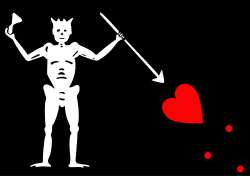 | |
| Modern fictional flag of Blackbeard | |
| Use | |
|---|---|
| Proportion | 3×2 |
| Design | A black banner with a horned skeleton holding an hourglass in his right hand and a spear in his left, using the spear to poke at a red heart dripping three red drops of blood |
The purported flag of Blackbeard, a variant of the "Old Roger design", consisting of a horned skeleton using a spear to pierce a bleeding heart, is typically attributed to the pirate Edward Teach, better known as Blackbeard. However, contrary to popular belief, there is no accurate description of any specific flag used by Blackbeard during his piracy beyond using "bloody flags" or black flags with "deaths heads". [1] Records from as early as 1723 report a flag of the same or very similar design to have been used by pirates, but not by Blackbeard in particular. [2]


